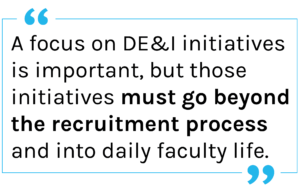Faculty are vital members of your campus community.
They drive learning, research, innovation, and student engagement at your university. Their roles are undoubtedly important—but many are feeling burned out after two years of uncertainty. If you’re concerned about faculty feeling supported on your campus, there are a few areas you can focus on.
Support mental health
There is a mental health crisis on college campuses right now. The isolation and stress of the pandemic pushed many students to a breaking point, and higher education institutions are responding by building new support systems on campus, increasing access to mental health counseling services, and engaging their communities in discussion about mental health.
When considering the mental health crisis, don’t forget about your faculty members. They are on the verge of burnout. The Chronicle reported, “More than two-thirds of faculty members say they felt extremely or very stressed over the past month, compared with about one-third at the end of 2019.”
Throughout the pandemic, some colleges and universities stepped up support of faculty with childcare help, technology support, or pausing the tenure clock. The next few years are an opportunity to take some lessons learned from the challenges of COVID-19 and apply them to your institutional policies going forward.
- How can you continue to offer flexibility or extra tech support to faculty who need it?
- How can you grow the conversation about mental health and well-being to include every member of campus?
- Can you expand access to mental health services to include faculty and staff, as well as students?
Create community—even for virtual community members
Higher education is built on community, so it’s important to maintain that community, even in a virtual environment, and to rebuild it as your campus finds a new sense of normalcy. A paper by Ithaka S+R noted, “When campuses closed in the spring, students, staff, and faculty relied on the relationships they developed in-person earlier in the semester or academic year. Many students, especially incoming students, will not have the benefit of those established relationships, and building those new relationships online takes more intention and effort.”
This is also true for incoming or new faculty, and even for well-established faculty facing an entirely new class of students. In a virtual environment, there are ways to build community — be sure that you’re providing faculty the support and education they need on how to create relationships in a digital classroom, and increase their feeling of belonging alongside the students.
The Ithaka S+R paper discussed other ways of building community for students that also apply to faculty, including increasing communication and collaboration. Communicating the plans and decisions of school leadership with faculty is vital to keeping them engaged and ensuring that they’re prepared for any upcoming changes. Collaboration is similarly important: involve your faculty in the decisions the institution is making. Be sure to engage them in the conversation, especially when decisions (like changes in teaching modalities or new technologies) will impact their daily work.
Don’t leave anyone out
The pandemic had an unequal impact on higher education faculty. For instance, adjunct and contingent professors, who were already facing lower pay before 2020, saw an increase in workload and one-third reported having to cover the costs of switching to online teaching from their own pockets. The last two years have also seen increased inequality for men and women faculty, with more women than men reporting an increased workload and difficulty balancing caregiving responsibilities.
 A supportive community for faculty means support for everyone, not just those in the majority. A focus on DE&I initiatives is important, but those initiatives must go beyond the recruitment process and into daily faculty life. Be sure to consider the needs of adjunct faculty in your decision-making processes, and take a look at different departments’ workload distribution and salaries to ensure there is no gender or racial bias at play. You can dive deeper into the metrics at your institution with tailored insights from PeopleAdmin’s HigherEd platform—learn more here.
A supportive community for faculty means support for everyone, not just those in the majority. A focus on DE&I initiatives is important, but those initiatives must go beyond the recruitment process and into daily faculty life. Be sure to consider the needs of adjunct faculty in your decision-making processes, and take a look at different departments’ workload distribution and salaries to ensure there is no gender or racial bias at play. You can dive deeper into the metrics at your institution with tailored insights from PeopleAdmin’s HigherEd platform—learn more here.
Ease stressful processes like tenure review
Faculty stress often comes from outside the classroom. Administrative responsibilities can take up huge amounts of faculty time and feel disconnected from their central work of teaching, research, and service. One process that is especially time-consuming and stressful is tenure and promotion review. The process is full of specific and sometimes opaque requirements, and applicants need to gather their life’s work into one place—which is even more difficult at the almost half of institutions who rely on paper processes for their faculty. You can simplify and ease these challenges for faculty by digitizing and creating a centralized, streamlined, and much faster review process for everyone involved. PeopleAdmin’s Faculty Information System is built to relieve that burden on faculty, contributing to a campus culture that values and supports its faculty body.
Final thoughts
Don’t let your faculty become part of “the great faculty disengagement,” as the Chronicle called it. Make sure your campus culture supports your faculty, and you’ll see the results in retention, in student engagement, and in innovation.